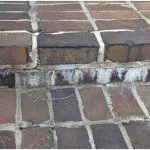The Basics of Brick Stair Maintenance
As if Chicago’s weather wasn’t hard enough on brick stairs, homeowners can unknowingly make it worse when their garden sprinklers water the stairs as much as the landscape, or when salt is applied to the stairs to melt ice. When homeowners use rock salt on brick steps, the salt becomes dissolved in melting snow or ice and seeps into the mortar. Expansion and contraction eventually cause cracking of the mortar.
Regular brick stair maintenance can prevent costly stair replacement
Spring is a good time to assess your brick stairs to see if repairs are needed. Look for loose or cracked mortar joints as well as flaking and spalling brick. If you can scrape a knife along the edge of the brick and it flakes and crumbles, it needs immediate attention. Take care of the problem at the onset and you may only need spot tuckpointing and a few bricks, versus a complete stair rebuild.
Older brick is generally more porous. If water is immediately absorbed and turns the brick dark, the brick may be in need of waterproofing. Choosing the right sealer is important because the wrong sealer can actually trap in moisture and accelerate the problem.
Before repairing brick stairs with tuckpointing or repointing, a tuckpointing contractor or masonry contractor will identify and address the source of any water damage. This is the only way to ensure that repairs will last. Make brick maintenance part of your annual routine and you will probably be able to avoid a costlier project such as a complete stair rebuild. Always seek out a licensed, insured and bonded tuckpointing contractor to provide advice on how to protect your investment.
John Gallagher is the owner of Shamrock Tuckpointing, a licensed, insured and bonded tuckpointing contractor serving Chicago and the suburbs.



